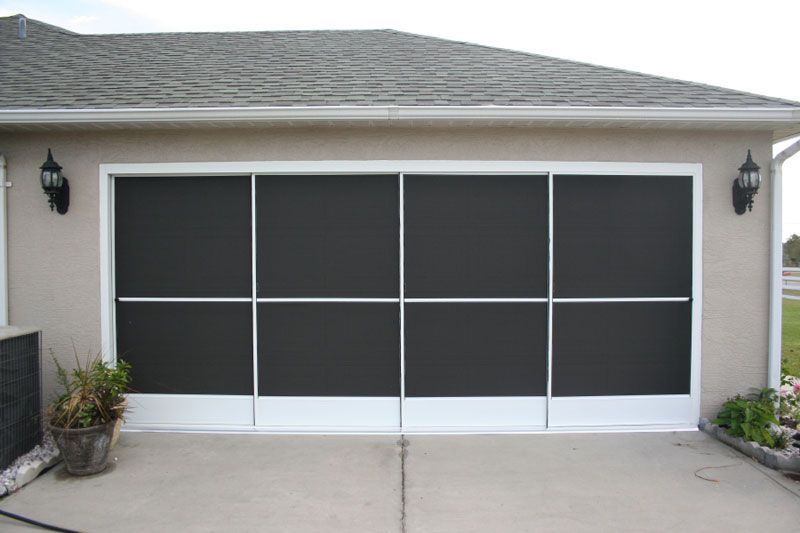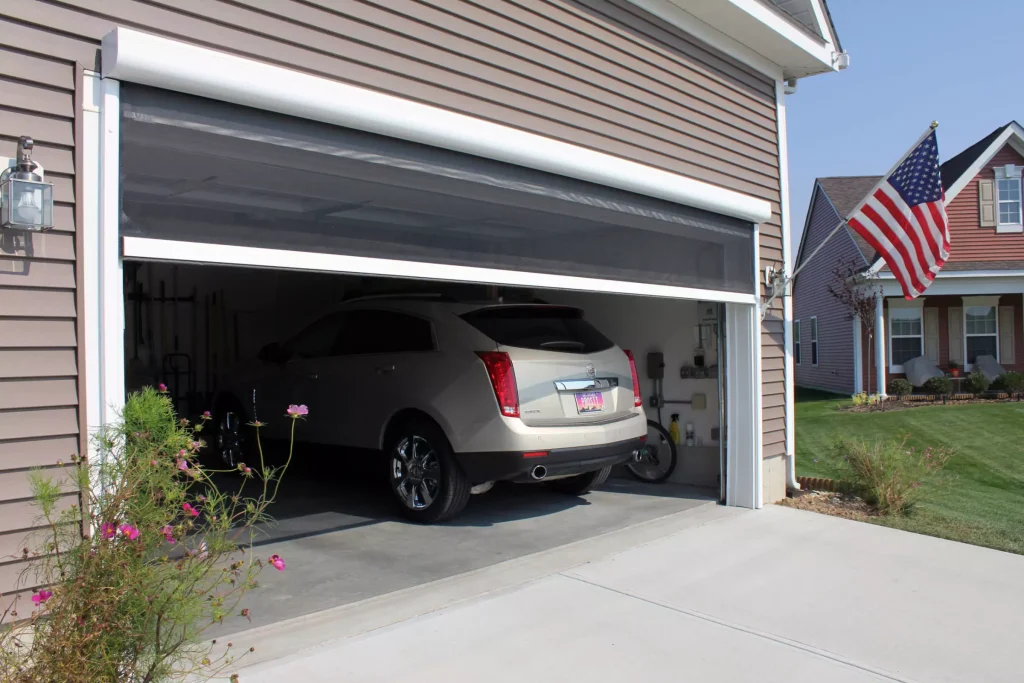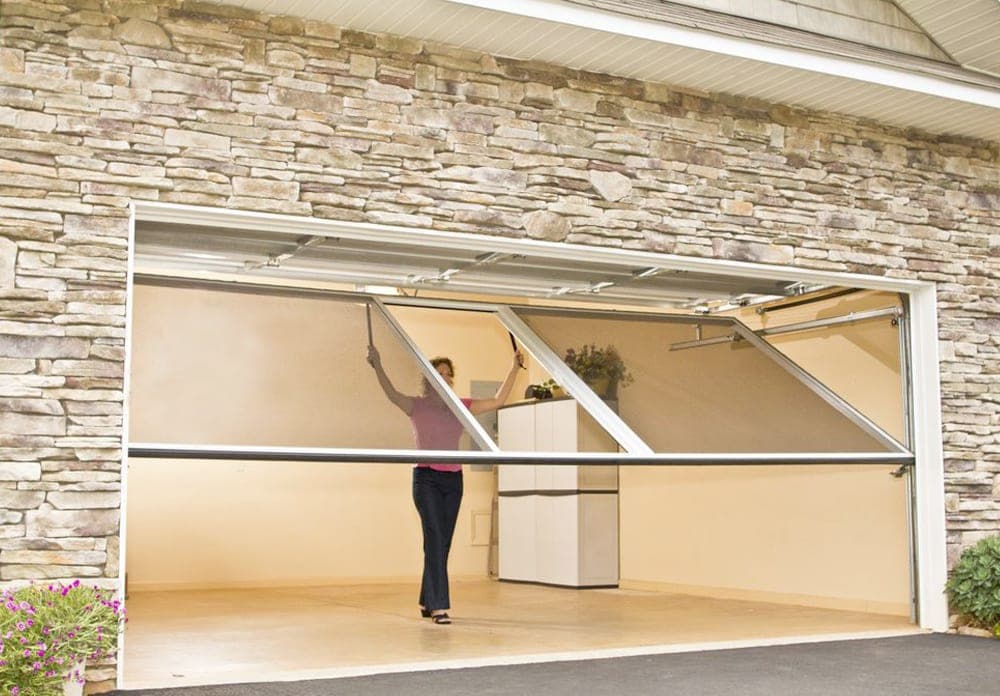The Ultimate Garage Upgrade: How Garage Door Screens Enhance Your Home
As a homeowner, you know the value of protecting your property and maintaining a comfortable living environment. Your garage is an essential part of your home, providing storage space, protection for your vehicles, and even serving as a workspace. However, conventional garage setups often lack the convenience and versatility needed to fully enjoy this space. This is where garage door screens come into the picture, offering a practical solution that enhances the way homeowners use their garages.
What are Garage Door Screens?
Garage door screens are mesh-like structures designed to cover the opening of a garage door. They are installed on the interior or exterior of the garage door and provide an additional layer of protection and functionality. The primary purpose of a garage door screen is to allow fresh air to flow into the garage while keeping bugs, insects, leaves, debris, and even small animals out. It essentially turns your garage into a more comfortable and usable space, creating an extended living area.
Types of Garage Door Screens:
- Retractable Garage Door Screens: These screens are mounted on tracks, allowing them to be easily pulled down when needed and retracted back when not in use. They are usually operated manually but can also be motorized for added convenience.
- Sliding Garage Door Screens: Sliding screens function similarly to retractable screens but are moved horizontally along a track instead of vertically. They are a good option for garages with limited vertical clearance.
- Roll-up Garage Door Screens: These screens consist of vertical panels that can be rolled up and secured at the top of the garage door when not in use. They are commonly made of vinyl or other flexible materials.
- Fixed Garage Door Screens: Unlike the retractable, sliding, or roll-up screens, fixed screens are installed permanently and cannot be easily moved out of the way. They are a more cost-effective option but lack the flexibility of other types.
Materials Used in Manufacturing Garage Door Screens:
- Fiberglass: Fiberglass is a popular material for garage door screens due to its durability, flexibility, and resistance to rust and corrosion. It provides good visibility and is an excellent option for areas with high humidity or exposure to the elements.
- Aluminum: Aluminum screens are lightweight, sturdy, and resistant to rust, making them a suitable choice for both interior and exterior garage door screens. They are commonly used in retractable and sliding screen systems.
- Vinyl: Vinyl screens are cost-effective and easy to maintain. They are often used in roll-up garage door screens due to their flexibility and ability to withstand frequent rolling and unrolling.
- Polyester: Polyester screens are strong and resistant to tearing, making them a durable option for garage door screens. They are often coated with PVC for added protection against UV rays and other environmental factors.
- Stainless Steel: Stainless steel screens offer exceptional strength and longevity. They are well-suited for areas prone to high wear and tear or for homeowners looking for a premium option.
- How Garage Door Screens Work:
Garage door screens are a popular addition to many homes, providing numerous benefits such as ventilation, pest control, and added utility space without compromising security. They are typically used to cover the garage door opening, allowing fresh air to flow into the garage while keeping insects, debris, and other unwanted elements out. Let’s delve deeper into how garage door screens work and the various types available:
Mechanics of Retractable Garage Door Screens: Retractable garage door screens are designed with a flexible mesh material that can be rolled up or pulled down as needed. The screen housing, usually mounted above the garage door opening, contains a roller and spring mechanism that enables smooth operation. When you want to use the screen, you can easily pull it down to cover the garage door opening, and when not in use, it retracts neatly into its housing. The mesh is typically made of durable materials like fiberglass or polyester, which allow air to pass through while keeping insects out.

Operation of Sliding and Roll-Up Garage Door Screens:
- Sliding Garage Door Screens: Sliding screens are designed to move horizontally along a track installed on the sides of the garage door opening. They can be manually operated by sliding them to the desired position, covering or uncovering the garage door opening. Some sliding screens also come with motorized options for added convenience.
- Roll-Up Garage Door Screens: Roll-up screens, as the name suggests, roll up into a housing located above the garage door when not in use. They are operated by pulling down on a handle or using a motorized system to lower the screen to the desired position. These screens are great for easy storage and quick access to the garage.
Manual vs. Motorized Garage Door Screens:
- Manual Garage Door Screens: Manual screens are operated by hand, and they typically have a pull-down handle or strap that allows users to lower and raise the screen. While manual screens are generally more affordable, they may require a bit more effort to operate, especially for larger screens.
- Motorized Garage Door Screens: Motorized screens are equipped with an electric motor that automates the opening and closing process. They often come with remote controls, wall-mounted switches, or even smartphone apps for convenient operation. Motorized screens are especially useful for larger screens or for individuals who prefer the ease of automation.
Integration with Existing Garage Door Systems: Garage door screens can be designed to work in tandem with existing garage door systems. Many models are compatible with various garage door types, including overhead doors, sectional doors, and some even work with commercial garage doors. They can be installed either inside the garage opening or on the outside, depending on the user’s preference and the space available.
Some advanced models of garage door screens are designed to integrate seamlessly with smart home systems, allowing homeowners to control the screens remotely, schedule opening and closing times, and receive notifications about their status.
The Functionality of Garage Door Screens:
Garage door screens are a versatile and practical addition to any home, offering various functionalities that enhance the usability and comfort of the garage space. Here’s a detailed look at the different benefits they provide:
Temperature and Climate Control Benefits:
Garage door screens help regulate the temperature inside the garage by allowing fresh air to flow in during pleasant weather. This prevents the garage from becoming excessively hot and stuffy, especially during the summer months. By keeping the garage more comfortable, it also reduces the workload on air conditioning systems, leading to potential energy savings.
During colder seasons, garage door screens can be rolled up or partially opened to let in sunlight and warmth, which can be beneficial for people who use the garage for hobbies or workspaces. This climate control feature makes the garage a more inviting area for various activities year-round.
Ventilation and Air Circulation Advantages:
Proper ventilation is crucial for garages, particularly if there are chemicals, paints, or other potentially harmful substances stored inside. Garage door screens facilitate the flow of fresh air, helping to prevent the buildup of fumes, odors, and stagnant air that may be detrimental to health. Improved air circulation also reduces the chances of mold and mildew growth in damp environments.
Keeping Insects, Pests, and Debris Out:
One of the primary functions of garage door screens is to act as a barrier against insects and pests. They provide an effective shield, preventing bugs, mosquitoes, and other unwanted critters from entering the garage. This feature is especially valuable in areas with a high insect population or during warm months when bugs are more active.
Additionally, garage door screens keep out leaves, dust, and debris, ensuring that the garage remains cleaner and more organized. It saves homeowners the hassle of frequently sweeping or cleaning the garage floor.
Creating an Additional Living or Workspace Area:
Garage door screens offer the option to transform the garage into an additional living or workspace area, effectively extending the usable space of the home. With the screens in place, the garage can serve as an open-air recreational area for family gatherings, parties, or relaxation.
Furthermore, the improved ventilation and natural light make the garage a suitable space for hobbies, DIY projects, or home workshops. Artists, craftsmen, and hobbyists can benefit from the flexibility and convenience of working in a semi-outdoor environment without being fully exposed to the elements.
Privacy Considerations with Garage Door Screens:
Privacy is a significant consideration when using the garage as an extended living or workspace area. While garage door screens allow for airflow and visibility from the inside, they often obscure the view from the outside. This means that people inside the garage can enjoy a level of privacy while still having a view of the surroundings.
However, it’s important to note that garage door screens do not offer the same level of privacy as solid walls or traditional doors. They are best suited for situations where privacy is a secondary concern, and the primary focus is on creating an open and airy space.
Maintenance and Care of Garage Door Screens:
Garage door screens serve as an essential barrier to keep bugs, debris, and pests out while allowing fresh air to circulate through the garage space. Proper maintenance and care are crucial to ensure their longevity and functionality. Here are some important tips for cleaning and upkeep, addressing common issues, troubleshooting, and scheduling regular maintenance checks:
Cleaning and Upkeep Tips for Different Types of Screens:
- Retractable Screens: Retractable screens are popular for their convenience and space-saving design. To clean them, start by removing any loose debris or dust using a soft brush or vacuum cleaner. Next, wipe the screen surface gently with a damp microfiber cloth or sponge using a mixture of mild soap and water. Avoid using harsh chemicals or abrasive cleaning agents as they may damage the screen material. Rinse the soap residue thoroughly and let the screen air-dry before retracting it.
- Sliding Screens: Sliding screens are usually made of mesh or fiberglass material. Regularly inspect the tracks and rollers for dirt, debris, or obstructions. Use a stiff brush to clean the tracks and lubricate the rollers with silicone-based lubricant. Gently wash the screens with a mixture of warm water and mild detergent, followed by a rinse and air-drying.
- Roll-Up Screens: Roll-up garage door screens are often made of vinyl or PVC-coated polyester. To clean them, use a soft brush or cloth to remove loose dirt, and then wash the screen with a mixture of warm water and mild soap. Avoid using high-pressure water as it may damage the screen material or its sealing. After cleaning, roll up the screen carefully and secure it in place.
Addressing Common Issues and Troubleshooting:
- Screen Tears or Holes: Regularly inspect the screens for tears or holes, as they can compromise the effectiveness of the garage door screen. Small tears can often be patched using screen repair kits available at hardware stores. For larger damages, consider contacting a professional for repair or replacement.
- Sticky Roll-Up: If you encounter difficulties while rolling up the garage door screen, it may be due to debris or dirt buildup along the tracks or within the roll-up mechanism. Clean the tracks and moving parts thoroughly and lubricate them with silicone-based lubricant to ensure smooth operation.
- Misaligned Retractable Screens: In case your retractable screen doesn’t close or open properly, check for any obstructions or debris that might be hindering its movement. If the problem persists, consult the manufacturer’s guidelines or seek professional assistance.
Scheduling Regular Maintenance Checks:
- Quarterly Inspections: Plan quarterly inspections of your garage door screens to identify any signs of wear, tear, or damage. Look for loose or damaged parts, tears in the mesh, or signs of rust on metal components.
- Lubrication: Apply lubricant to rollers, tracks, and hinges at least twice a year or as recommended by the manufacturer. This helps prevent friction-related issues and ensures smooth operation.
- Professional Maintenance: Consider scheduling professional maintenance checks once a year to have a trained technician thoroughly inspect and service your garage door screens. They can identify potential issues early on and perform any necessary repairs.
By following these maintenance and care tips, you can extend the life of your garage door screens, keep them functioning properly, and enjoy bug-free ventilation in your garage space for years to come.
Safety and Security:
Garage door screens have become increasingly popular in recent years due to their ability to provide additional functionality to a garage space. These screens are typically made of durable materials and allow homeowners to transform their garages into more versatile spaces, such as workshops, recreational areas, or even extra living space. However, while garage door screens offer various benefits, they can also impact home security if not installed and used correctly.
- Visual Access and Deterrence: One potential concern with garage door screens is that they may provide outsiders with a glimpse of the contents inside the garage. If valuable items are visible, it could attract the attention of potential thieves or burglars. Moreover, some screens might not offer complete privacy, making it easier for intruders to observe activities inside the garage and potentially plan a break-in.
- Reduced Physical Barriers: Traditional garage doors serve as substantial physical barriers to prevent unauthorized access. With a garage door screen, the primary door is open, and the screen becomes the main point of entry. Although the screen may have some security features, it generally doesn’t offer the same level of protection as a solid garage door.
- Risk of Unintentional Access: If the garage door screen is not adequately secured or accidentally left open, it could provide easy access to the garage and potentially the rest of the house. This risk increases if the screen is not properly maintained and becomes damaged or worn over time.
Ensuring Proper Installation and Security Features:
To maximize home security when using garage door screens, it’s essential to consider the following:
- High-Quality Materials: Invest in a high-quality garage door screen made of durable materials that offer increased security features. Look for screens with reinforced edges and sturdy zippers or locking mechanisms to reduce the risk of unauthorized access.
- Professional Installation: Hire a reputable and experienced professional to install the garage door screen correctly. Proper installation ensures that the screen fits snugly and functions as intended, minimizing potential security gaps.
- Integrated Security System: Consider integrating the garage area into the home’s overall security system. This can include adding motion sensor lights, security cameras, or even an alarm system specifically designed for the garage space. These additional security measures can deter intruders and provide homeowners with peace of mind.
Best Practices for Using Garage Door Screens Safely:
- Limited Visibility: Store valuable items and personal belongings away from the line of sight of the garage door screen. This reduces the likelihood of attracting unwanted attention from potential intruders.
- Regular Maintenance: Perform routine maintenance checks on the garage door screen to ensure it remains in good working condition. Promptly repair any damages or wear and tear to maintain the screen’s integrity and security features.
- Secure Closure: Always double-check that the garage door screen is fully closed and properly secured before leaving the area or going to bed. This simple step can prevent unintentional access.
- Awareness and Education: Educate all household members about the proper use of the garage door screen and the importance of home security. Encourage vigilance and communication when it comes to potential security risks.
By being proactive in implementing security measures and using garage door screens responsibly, homeowners can enjoy the benefits of an expanded garage space without compromising the safety and security of their home.
Frequently Asked Questions
What is a garage door screen?
A garage door screen is a type of retractable or removable mesh screen system that is designed to cover the opening of a garage door. It allows fresh air and natural light to enter the garage while keeping insects, debris, and pests out.
How does a garage door screen work?
Garage door screens are typically made of durable mesh material that can be easily pulled down or across the garage door opening. Some screens are manual and require you to operate them by hand, while others can be motorized for more convenient use. The screens are guided by tracks on the sides of the garage door frame, ensuring smooth operation.
Can I still use my garage door with the screen installed?
Yes, most garage door screens are designed to be easily retracted or lifted when you need to use the garage door. They can be conveniently rolled up or moved out of the way, allowing you to access your garage as usual.
Are garage door screens durable?
Generally, garage door screens are made of sturdy materials, such as polyester or vinyl-coated polyester mesh. These materials are designed to withstand outdoor elements and regular usage. However, the durability may vary depending on the brand and quality of the screen, so it’s essential to choose a reputable product.
Can I install a garage door screen myself?
Yes, many garage door screens come with straightforward DIY installation instructions. However, if you’re not comfortable with DIY projects or if the screen is motorized, it’s best to hire a professional installer to ensure proper setup and functionality.
Conclusion:
In conclusion, garage door screens are more than just an accessory; they significantly enhance the functionality of garages and add value to modern households. With increased versatility, bug and pest control, improved ventilation, energy efficiency, enhanced privacy, debris protection, and seasonal adaptability, these screens are a practical and cost-effective investment for homeowners. As technology advances, we can expect even more innovative features and materials that will further improve the functionality and usability of garage door screens in the future.


